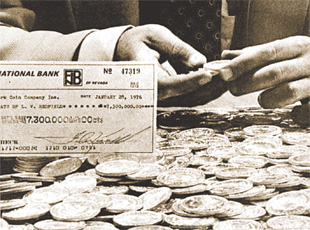Famous U.S. Hoards
Throughout time, people have been fascinated with "buried treasure". Today, coin collecting offers a modern version of the thrill of the hunt – U.S. coin hoards. Discovering a large group of coins or paper money, especially those amassed under remarkable conditions, is one of collecting's most exciting possibilities! Many existing hoards have already been found and dispersed through sales and auctions. However, there are certainly more groups just waiting to be discovered – in fact, Littleton revealed its latest find, the Big Sky Hoard of Eisenhower dollars, in 2011!
Big Sky Hoard (2011)
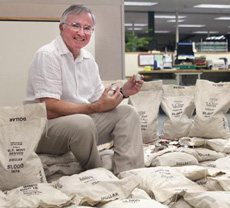
After thirty years in a Montana bank vault, a previously unknown hoard of over 220,000 Eisenhower dollars was discovered in 2011. Put away for years by a prominent Montana family, most of the coins in this remarkable hoard were still in original mint-sewn bags and were untouched by the wear and tear of general circulation. Shipped from the Denver Mint right to a Federal Reserve Bank in Montana, the coins missed the traditional movement between the mint and local banks, and escaped the widespread use of "Ike" dollars in western casinos.
Learn more about the Big Sky Hoard.
Frome Hoard of Ancient Roman Coins (2010)
The Frome Hoard of 52,503 ancient Roman coins was discovered in 2010 near the town of Frome in Somerset, England. Contained in a large buried ceramic pot and dating from A.D. 253-305, many of the coins were struck under the central Roman Empire, others were minted under the breakaway Gallic Empire, and some were issued by the independent Britannic Empire. While most ancient hoards were assumed to be buried for safekeeping, this pot was so large and fragile that the hoard may have been a communal offering to the gods.
Alabama Hoard (2002)
One family held a stack of 1864 State of Alabama Southern States Notes for more than 135 years. Still looking much as they did when printed in Montgomery over a century before, the Crisp Unused $5 and $10 notes presented a window on the Confederacy with their vignettes of plantation life. Littleton's buyers purchased over 300 of the Confederate Notes, each of which was individually hand signed and numbered.
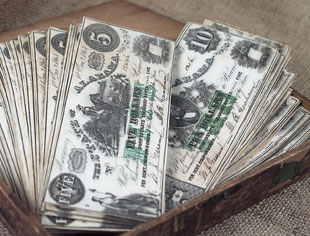
Steamer Trunk Hoard (2000)
Littleton's team bought 171 $20 Confederate Notes with consecutive serial numbers from an original brick issued more than a century ago. Since the Crisp Uncirculated 1864 notes might have languished unnoticed in a piece of luggage, Littleton's buyers called the stash the Steamer Trunk Hoard.
Southern “CC” Cache (1999)
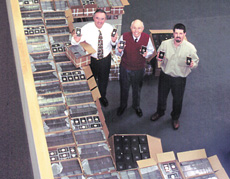
A Georgia collector sold Littleton buyers one of the largest hoard of Carson City silver dollars since the U.S. Treasury Department emptied its vaults in 1980. Stored for years in a former southern bank building, the stash contained 8,261 lustrous Morgans in original General Services Administration (GSA) holders, including 378 1885-CC Morgans – the lowest mintage in the series.
Montana Hoard (1998)
Mistrustful of banks, George Bouvier of Deer Lodge, Montana, hid 8,000 silver dollars and other coins he'd accumulated during his lifetime in his house walls. He also buried coffee cans full of coins under the floor of his shop. On his deathbed, he told a young friend about the hoard. The youth later told Bouvier's relatives, whose search turned up over 17,000 coins. Littleton's buying team purchased enough Morgan dollars from the hoard to assemble 500 all-mint sets of 1921 Morgan silver dollars.
Buffalo Nickel Hoard ( 1998)
Buffalos stampeded into Littleton after the company bought a hoard of 300,000 – the largest one-time purchase of Buffalo nickels in the firm's history. Sold by a western states dealer, some were still in Wells Fargo bank bags. The 3,300-pound delivery arrived at Littleton's headquarters in a Brink's armored car.
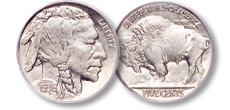
Midwest MegaHoard (1998)
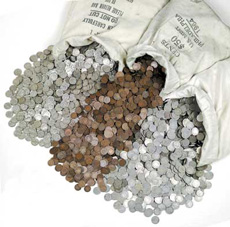
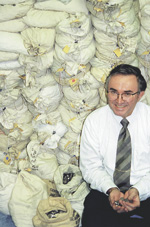
Littleton bought the largest coin hoard ever, holding 1.7 million Indian Head cents and Liberty and Buffalo nickels! Hidden in the walls of a Midwest collector's house, the stash had been out of circulation since the 1950s and '60s. The coins, weighing 7.6 tons, were stored in canvas sacks and 55‑gallon drums.
California Coin Cache (1997)
A California hoard that had been accumulating for years yielded 3,671 Flying Eagle cents dated 1857 & 1858. This was believed to be the largest group ever to be purchased at one time. The three previously known largest Flying Eagle cent hoards contained only a fraction of the coins comprising this cache. The entire group contained 8,467 U.S. type coins from the 18th & 19th centuries.
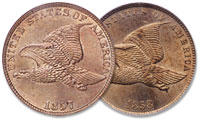
New York Subway Hoard (1996)
For years, a certain New York subway token seller sifted through change seeking scarce coins. Many coins were marketed through George Shaw, a rare coin dealer. After Shaw's death, Littleton Coin buyers acquired the many coins, including Type I 1916 Standing Liberty quarters, 1916-D Mercury dimes, 1914-D Lincoln cents, and other key‑date coins.
Vermont Yankee Hoard (1996)
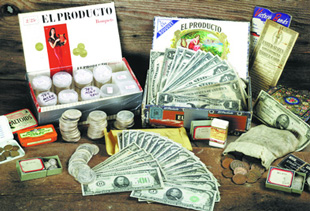
Frugal Yankees A.K. and Imogene Miller lived a spartan life in Vermont. She wore raincoats made from plastic bags. He pedaled a 1903 bicycle with patched tires. Yet, after they died, an estimated $3,000,000 fortune was found hidden in the buildings and beneath the floor of the schoolhouse on their property. Littleton purchased first-year Uncirculated 1878-S Morgans, scarce $500 and $1,000 Federal Reserve Notes, and the rare Miss Drury tokens – calling the stash the Vermont Yankee Hoard.
Reno Casino Hoard (1996)
For 20 years, Rudy, a Reno, Nevada casino worker, traded his own money for Carson City Morgans whenever he spotted them in the coins he sorted through daily. As Morgans grew scarcer, he began “saving” all silver dollars. By Rudy's retirement, he had amassed 4,100 silver dollars including more than 3,312 Morgans. In the hoard, Littleton's buyers discovered scarce “O over S” Morgans, created when a San Francisco reverse die was repunched with an “O”.
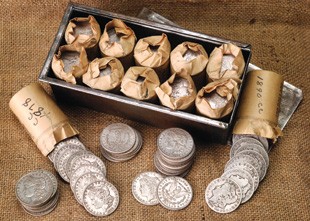
1927-D Peace Dollar Hoard (1992)
Silver for the 25th Wedding Anniversary
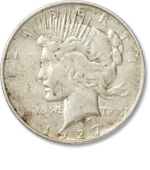
The 1927-D silver dollars are the 2nd rarest Denver Mint Peace dollars in Uncirculated condition, so Littleton's buyers leapt into action when they learned that 2½ mint bags (2,500) of 1927-D Peace dollars would be auctioned off through Sotheby's of New York. A husband had given the silver dollars to his wife in 1927 for a 25th wedding anniversary gift. The coins had been locked in a bank vault for 65 years before the family decided to sell them through the famous auction house. Despite fierce bidding for these very scarce dollars, Littleton acquired over 2,000 of them, and customers quickly snatched them up.
Wells Fargo Hoard of Saint-Gaudens Gold (1990s)
In the early 1990s, nearly 10,000 high-quality 1908 "No Motto" Saint-Gaudens $20 gold pieces came to light and were dubbed the "Wells Fargo Hoard" – because the first transactions involving the hoard took place in a Las Vegas Wells Fargo bank. Thousands of the coins were graded Gem Uncirculated MS-66 by PCGS, nearly 1,000 were graded Superb Gem MS-67, 101 received rare MS-68 grading, and 10 coins were graded MS-69! PCGS called the MS-69's "the most amazingly perfect Saints we had ever seen."
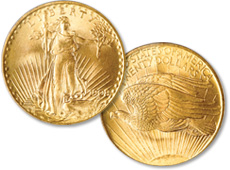
S.S. Central America Shipwreck Hoard (1987)
The S.S. Central America was a 280-foot sidewheel steamer that operated between Central America and eastern U.S. ports. Embarking from Panama in September 1857, the S.S. Central America sidewheel steamer sank in a hurricane off the coast of Virginia with 400 passengers and over 30,000 pounds of gold bullion and coins. After the shipwreck was discovered in 1987, about 95% of recovered coins were found to be 1857-S Liberty Head $20 gold pieces – most of the San Francisco Mint's production of $20 gold coins for the year 1857!
Continental-Illinois National Bank Hoard (1980s)
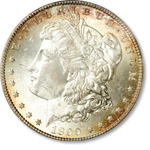
For over a century, the Continental-Illinois National Bank in Chicago kept a portion of its cash reserves in original mint bags of Morgan silver dollars. Facing financial difficulties during the 1980s, the bank decided to sell the coins for their collector value, which was very considerable as many of the Morgan dollars exhibited spectacular luster, beautiful rainbow toning, and outstanding strikes. There was great demand for the high-quality silver dollars among collectors.
Redfield Hoard (1974)
LaVere Redfield was a "hard money" fanatic who hated the government and refused to pay taxes. After moving to Reno, Nevada in the 1930s with some money he had made through oil and stock investments, Redfield, a wildly eccentric character, enjoyed looking the part of a poor farmer and was generally considered a cheapskate. But Redfield was inconsistent. He would hitchhike to save gas but would gamble away thousands of silver dollars at Reno casinos!
Redfield was not a coin collector. He did, however, have a unique interest in Morgan silver dollars. Friends at local banks would let him know when they had bags of silver dollars, usually Morgans. Redfield would go to the bank and buy these silver dollars, paying astonishing amounts of paper money for them.
When he brought the coins home, there was no exciting digging through the bags, searching for conditions or key-date coins, or proudly displaying albums of beautiful Morgans. Instead, Redfield often dropped the bags of silver dollars down a coal chute to be stored in his cellar. Redfield amassed more than 500,000 silver dollars over three decades.
After Redfield's death in 1974, a complete inventory of his estate was taken. Between 520,000 and 650,000 silver dollars were found, dwarfing any previous hoard! A judge decreed that the best way to settle Redfield's estate was to hold an auction for the coins. When it was over, the A-Mark Coin Company became the new owner of the Redfield Hoard for $7.3 million! An exact inventory of the hoard has never been released and details of the purchase are to this day vague.
